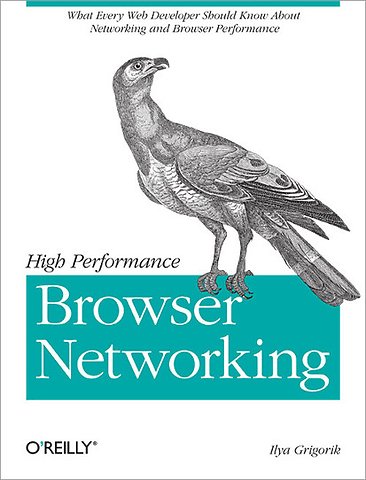High Performance Browser Networking
What Every Web Developer Should Know About Networking and Browser Performance
Samenvatting
How prepared are you to build fast and efficient web applications? This eloquent book provides what every web developer should know about the network, from fundamental limitations that affect performance to major innovations for building even more powerful browser applications-including HTTP 2.0 and- XHR improvements, Server-Sent Events (SSE), WebSocket, and WebRTC.
Author Ilya Grigorik, a web performance engineer at Google, demonstrates performance optimization best practices for TCP, UDP, and TLS protocols, and explains unique wireless and mobile network optimization requirements. You'll then dive into performance characteristics of technologies such as HTTP 2.0, client-side network scripting with XHR, real-time streaming with SSE and WebSocket, and P2P communication with WebRTC.
- Deliver superlative TCP, UDP, and TLS performance
- Speed up network performance over 3G/4G mobile networks
- Develop fast and energy-efficient mobile applications
- Address bottlenecks in HTTP 1.x and other browser protocols
- Plan for and deliver the best HTTP 2.0 performance
- Enable efficient real-time streaming in the browser
- Create efficient peer-to-peer videoconferencing and low-latency applications with real-time WebRTC transports
Specificaties
Inhoudsopgave
U kunt van deze inhoudsopgave een PDF downloaden
Preface
Part 1: Networking 101
1. Primer on Latency and Bandwidth
-Speed Is a Feature
-The Many Components of Latency
-Speed of Light and Propagation Latency
-Last-Mile Latency
-Bandwidth in Core Networks
-Bandwidth at the Network Edge
-Delivering Higher Bandwidth and Lower Latencies
2. Building Blocks of TCP
-Three-Way Handshake
-Congestion Avoidance and Control
-Bandwidth-Delay Product
-Head-of-Line Blocking
-Optimizing for TCP
3. Building Blocks of UDP
-Null Protocol Services
-UDP and Network Address Translators
-Optimizing for UDP
4. Transport Layer Security (TLS)
-Encryption, Authentication, and Integrity
-TLS Handshake
-TLS Session Resumption
-Chain of Trust and Certificate Authorities
-Certificate Revocation
-TLS Record Protocol
-Optimizing for TLS
-Performance Checklist
-Testing and Verification
Part 2: Performance of Wireless Networks
5. Introduction to Wireless Networks
-Ubiquitous Connectivity
-Types of Wireless Networks
-Performance Fundamentals of Wireless Networks
-Measuring Real-World Wireless Performance
6. WiFi
-From Ethernet to a Wireless LAN
-WiFi Standards and Features
-Measuring and Optimizing WiFi Performance
-Optimizing for WiFi Networks
7. Mobile Networks
-Brief History of the G's
-Device Features and Capabilities
-Radio Resource Controller (RRC)
-End-to-End Carrier Architecture
-Packet Flow in a Mobile Network
-Heterogeneous Networks (HetNets)
-Real-World 3G, 4G, and WiFi Performance
8. Optimizing for Mobile Networks
-Preserve Battery Power
-Eliminate Periodic and Inefficient Data Transfers
-Anticipate Network Latency Overhead
-Design for Variable Network Interface Availability
-Burst Your Data and Return to Idle
-Offload to WiFi Networks
-Apply Protocol and Application Best Practices
Part 3: HTTP
9. Brief History of HTTP
-HTTP 0.9: The One-Line Protocol
-HTTP 1.0: Rapid Growth and Informational RFC
-HTTP 1.1: Internet Standard
-HTTP 2.0: Improving Transport Performance
10. Primer on Web Performance
-Hypertext, Web Pages, and Web Applications
-Anatomy of a Modern Web Application
-Performance Pillars: Computing, Rendering, Networking
-Synthetic and Real-User Performance Measurement
-Browser Optimization
11. HTTP 1.X
-Benefits of Keepalive Connections
-HTTP Pipelining
-Using Multiple TCP Connections
-Domain Sharding
-Measuring and Controlling Protocol Overhead
-Concatenation and Spriting
-Resource Inlining
12. HTTP 2.0
-History and Relationship to SPDY
-The Road to HTTP 2.0
-Design and Technical Goals
-Brief Introduction to Binary Framing
13. Optimizing Application Delivery
-Evergreen Performance Best Practices
-Optimizing for HTTP 1.x
-Optimizing for HTTP 2.0
Part 4: Browser APIs and Protocols
14. Primer on Browser Networking
-Connection Management and Optimization
-Network Security and Sandboxing
-Resource and Client State Caching
-Application APIs and Protocols
15. XMLHttpRequest
-Brief History of XHR
-Cross-Origin Resource Sharing (CORS)
-Downloading Data with XHR
-Uploading Data with XHR
-Monitoring Download and Upload Progress
-Streaming Data with XHR
-Real-Time Notifications and Delivery
-XHR Use Cases and Performance
16. Server-Sent Events (SSE)
-EventSource API
-Event Stream Protocol
-SSE Use Cases and Performance
17. WebSocket
-WebSocket API
-WebSocket Protocol
-WebSocket Use Cases and Performance
-Performance Checklist
18. WebRTC
-Standards and Development of WebRTC
-Audio and Video Engines
-Real-Time Network Transports
-Establishing a Peer-to-Peer Connection
-Delivering Media and Application Data
-DataChannel
-WebRTC Use Cases and Performance
-Performance Checklist
Index
Anderen die dit boek kochten, kochten ook
Net verschenen
Rubrieken
- aanbestedingsrecht
- aansprakelijkheids- en verzekeringsrecht
- accountancy
- algemeen juridisch
- arbeidsrecht
- bank- en effectenrecht
- bestuursrecht
- bouwrecht
- burgerlijk recht en procesrecht
- europees-internationaal recht
- fiscaal recht
- gezondheidsrecht
- insolventierecht
- intellectuele eigendom en ict-recht
- management
- mens en maatschappij
- milieu- en omgevingsrecht
- notarieel recht
- ondernemingsrecht
- pensioenrecht
- personen- en familierecht
- sociale zekerheidsrecht
- staatsrecht
- strafrecht en criminologie
- vastgoed- en huurrecht
- vreemdelingenrecht








